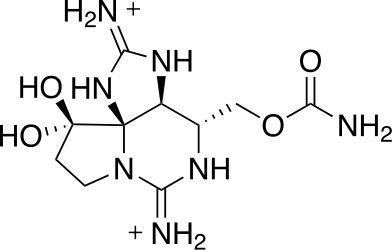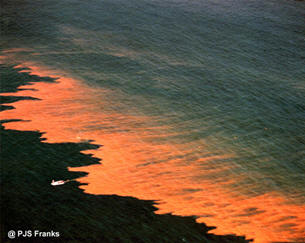Interactions
A number
of marine Dinoflagellates,
Alexandrium tamarense
being one of them, are known to produce toxins that kill
many fish and cause illness and even death to humans. This
toxin is called saxitoxin. Saxitoxin
is the toxin produced by Alexandrium tamarense
Symptoms
include:
1.
Tingling
of the lips and tongue
2.
Tingling
of fingers and toes
3.
Arm and
leg control loss
4.
Difficulty breathing
5.
Muscles
in the chest and abdomen become paralyzed
6.
Suffocation/death
(Washington State Department of Health)
All of these symptoms depend on the concentrations of PSP. As already discussed in the reproduction section, A. tamarense can have a cystic stage in its life cycle. According to a study during this cystic stage the organism can still harbor this poisonous toxin and the cysts are ten times more toxic then when in their motile stages (Dale et. al, 1978). This encystment stage is a major reason why it persists in areas across the globe.
Red Tide is a
contributor to Paralytic Shellfish Poisoning. They go hand
in hand because Red Tide is often the reason for outbreaks
of PSP in marine environments. Red Tide is an algal
bloom that happens in marine systems. These blooms can be
either toxic or not harmful at all. During these blooms saxitoxin can be released into the water for other
organisms to consume. It got its name Red Tide
from the fact that sometimes these algal blooms can turn
water red. The effect it can have on marine habitats can be
severe. Zooplankton grazes on algal blooms and if these
blooms are poisoned with Alexandrium
tamarense it can cause the deaths of many zooplankton.
This is important because zooplankton play an important role
as filter feeders in marine ecosystems.
blooms saxitoxin can be released into the water for other
organisms to consume. It got its name Red Tide
from the fact that sometimes these algal blooms can turn
water red. The effect it can have on marine habitats can be
severe. Zooplankton grazes on algal blooms and if these
blooms are poisoned with Alexandrium
tamarense it can cause the deaths of many zooplankton.
This is important because zooplankton play an important role
as filter feeders in marine ecosystems.
Next Stop: Facts!